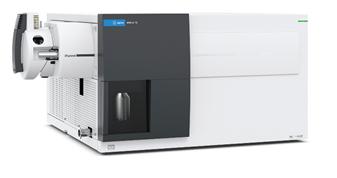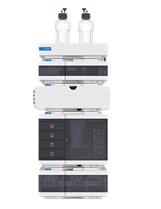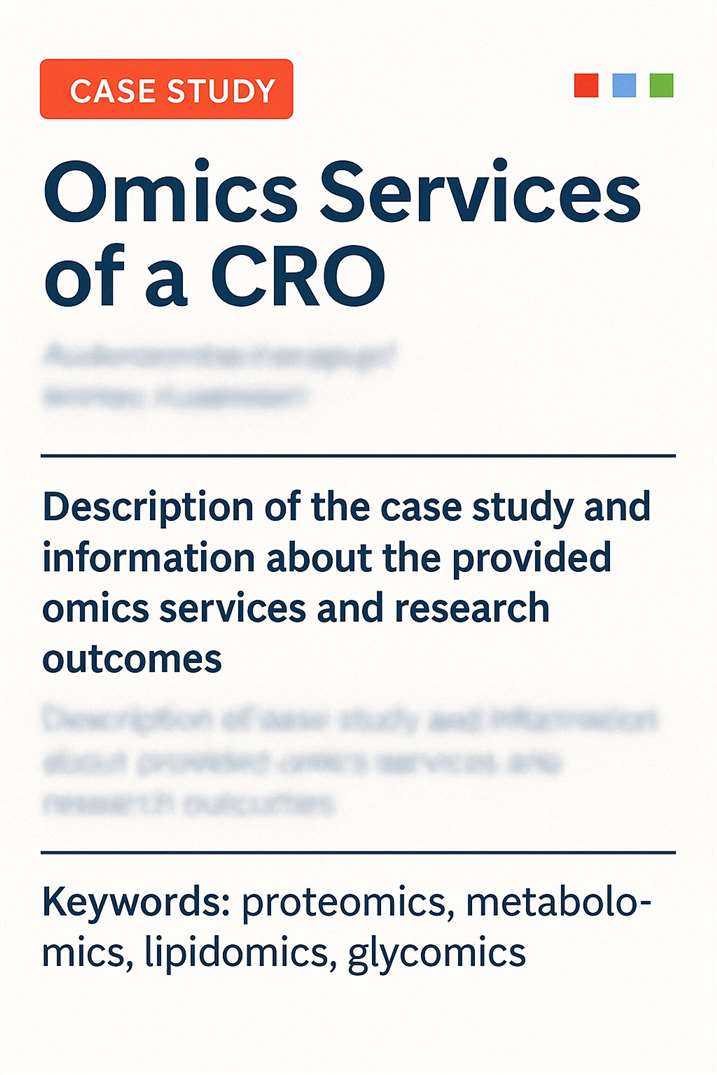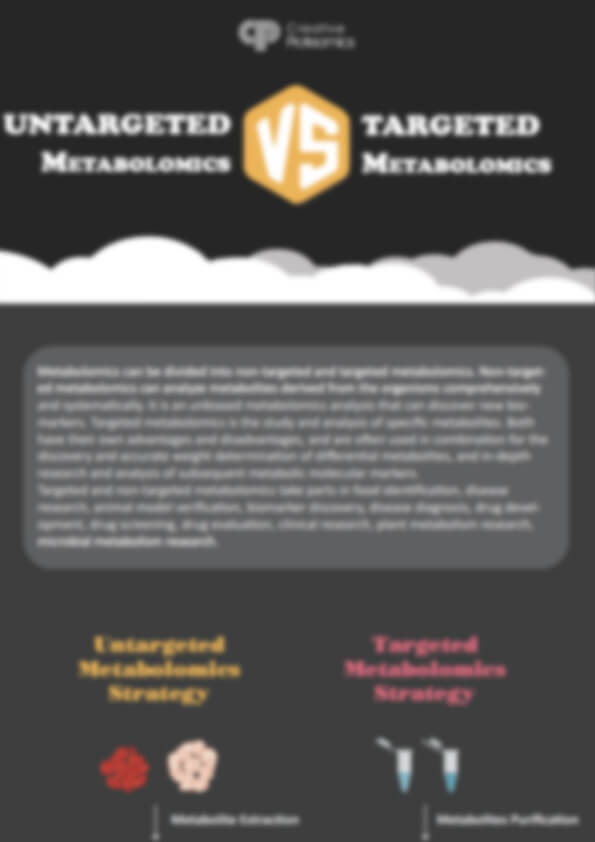Naphthylacetic Acid Analysis Service
Creative Proteomics offers high-sensitivity NAA (1-naphthaleneacetic acid) analysis through targeted quantification and metabolic profiling using LC-MS/MS.
We help you:
- Achieve accurate quantification of NAA with detection limits down to trace levels (ng/mL)
- Monitor multiple auxin-related metabolites involved in plant hormone signaling and metabolism
- Support hormone pathway research, tissue culture optimization, and residue risk assessment
- Analyze plant tissues, culture media, soil, and environmental matrices with optimized workflows
Accelerate your plant physiology, agricultural, or regulatory research with dependable, high-throughput analytical data.
Submit Your Request Now
×
What You Will Receive
- Quantified NAA concentrations (ng/g or ng/mL)
- Internal standard-corrected chromatograms
- Standard curve with linearity data (R² ≥ 0.995)
- Custom reports with metabolite interpretation
- Optional pathway diagrams & degradation tracking
- What We Provide
- Advantages
- Technology Platform
- Sample Requirements
- Demo
- FAQs
- Case Study
Overview of Naphthylacetic Acid
Naphthylacetic acid (NAA) is a synthetic plant growth regulator that mimics natural auxins such as indole-3-acetic acid (IAA). It is widely used in agricultural biotechnology, tissue culture, and crop propagation to stimulate root development, prevent premature fruit drop, and promote overall plant growth. Due to its high stability and effectiveness, NAA is commonly applied in fruit trees, vegetables, ornamental plants, and plant tissue engineering.
Unlike natural auxins, NAA is not readily degraded in plant systems or the environment. As a result, accurate measurement of NAA and its metabolites is essential for evaluating its biological effects, optimizing application dosages, and ensuring regulatory compliance in food safety and environmental monitoring.
Why Analyze Naphthylacetic Acid?
Understanding how NAA behaves in your system—whether in crops, plant cultures, or field environments—can make a significant difference in research outcomes and product quality. Our Naphthylacetic Acid Analysis Service is designed to support:
- Plant hormone experiments that require precise control over auxin levels
- Optimization of tissue culture media and rooting protocols
- Safety evaluations of residual NAA in food and agricultural products
- Environmental tracking of synthetic auxin contamination in soil or water
- Mechanistic studies on auxin-related metabolic or signaling pathways
At Creative Proteomics, we use advanced LC-MS/MS and targeted metabolomics workflows to accurately detect, quantify, and profile NAA and its related compounds, even at trace levels. This ensures data accuracy and decision-making confidence, whether you are running basic research or applied industrial trials.
Naphthylacetic Acid Analysis Service Offered by Creative Proteomics
- Targeted Quantification via LC-MS/MS: Absolute quantification of NAA using stable isotope-labeled internal standards. Detection limit: < 1 ng/g (tissue).
- Auxin Metabolite Profiling: Simultaneous detection of NAA with natural auxins (e.g., IAA, PAA) and their oxidized or conjugated forms.
- Environmental Residue Testing: Detection of trace NAA in soil, hydroponic solution, and runoff water with validated sample preparation protocols.
- Stability & Degradation Studies: Monitoring NAA metabolism under different light, temperature, and enzymatic conditions in planta.
- Matrix Types Supported: Leaf, root, stem, seed, callus tissue, culture media, soil, and aqueous environmental samples.
Detected Naphthylacetic Acid and Related Analytes
| Compound Name | Abbreviation | Class | Related Pathway |
|---|---|---|---|
| 1-Naphthylacetic acid | NAA | Synthetic auxin | Auxin response modulation |
| Indole-3-acetic acid | IAA | Natural auxin | Tryptophan-dependent auxin biosynthesis |
| Indole-3-butyric acid | IBA | Natural auxin | Auxin conjugate and transport pathway |
| Phenylacetic acid | PAA | Natural auxin | Secondary auxin pathway |
| 1-Naphthol | NOL | NAA degradation product | Oxidative auxin breakdown |
| 1-Naphthylacetamide | NAM | Precursor/intermediate | Synthetic auxin metabolism |
| 2-Naphthylacetic acid | 2-NAA | Isomer (inactive) | Structural analog surveillance |
| IAA-Aspartate | IAA-Asp | Conjugated auxin | Auxin inactivation & storage pathway |
| IAA-Glucose | IAA-Glc | Conjugated auxin | Glycosylation and reversible storage |
| OxIAA (Oxindole-3-acetic acid) | OxIAA | Oxidized auxin | Auxin catabolic pathway |
Advantages of Naphthylacetic Acid Assay
- Ultra-Low Detection Limits: Quantification down to <1 ng/g in complex matrices such as plant extracts or soil.
- High Sample Throughput: Capable of processing >200 samples per batch with parallel quantification of multiple auxins.
- Exceptional Reproducibility: Coefficient of variation (CV) <5% across technical replicates and <10% across biological samples.
- Wide Dynamic Range: Linear quantification range from 0.001–10 µg/mL, suitable for both trace detection and bulk analysis.
- Customizable Panel: Auxiliary profiling of endogenous auxins, conjugates, and breakdown products for complete auxin pathway coverage.
- Comprehensive Reporting: Fully annotated reports with peak area quantification, standard curve calibration, and optional pathway mapping figures.
Workflow for Naphthylacetic Acid Analysis Service

Technology Platform for Naphthylacetic Acid Analysis Service
Liquid Chromatography-Tandem Mass Spectrometry (LC-MS/MS)
- Triple quadrupole instrumentation (e.g., SCIEX 6500+, Agilent 6495C)
- Electrospray ionization (ESI) in negative mode
- Quantification using isotope-labeled internal standards
High-Resolution Mass Spectrometry (HRMS) (optional)
- Applied for metabolite identification or untargeted pathway profiling
- Orbitrap or TOF systems for structural confirmation

Agilent 6495C Triple Quadrupole (Figure from Agilent)

Agilent 1260 Infinity II HPLC (Fig from Agilent)
Analytical Performance Specifications
| Parameter | Value / Range |
|---|---|
| Limit of Detection (LOD) | < 0.5 ng/g (tissue); < 1 ng/mL (media/water) |
| Limit of Quantification | < 1 ng/g |
| Linearity (R²) | ≥ 0.995 over 4–5 orders of magnitude |
| Precision (CV%) | < 10% (intra-batch); < 15% (inter-batch) |
| Matrix Compatibility | Plant, soil, aqueous, culture media |
| Throughput | Up to 96 samples/day |
Sample Requirements for Naphthylacetic Acid Analysis Service
| Sample Type | Recommended Amount | Storage Condition | Notes |
|---|---|---|---|
| Fresh plant tissue | ≥ 0.5 g (leaf, root, stem) | Freeze-dried or -80°C | Avoid repeated freeze-thaw cycles |
| Callus or cultured cells | ≥ 100 mg | -80°C | Collect rapidly and freeze immediately |
| Culture media | ≥ 2 mL | Store at 4°C or -20°C | Filter if containing debris |
| Soil/substrate samples | ≥ 5 g | Air-dried or -20°C | Store in clean polyethylene containers |
| Aqueous solutions | ≥ 2 mL | 4°C to -20°C | Submit in LC-MS–compatible vials if possible |
Demo Results
FAQ of Naphthylacetic Acid Analysis Service
Can I analyze both NAA and natural auxins like IAA in the same sample?
Yes. Our multiplex LC-MS/MS method can simultaneously quantify NAA alongside key endogenous auxins (e.g., IAA, IBA, PAA), enabling direct comparison or pathway profiling.
What is the minimum sample amount required for accurate analysis?
We recommend at least 0.5 g of fresh tissue or 100 mg of dry plant material. For media or liquid samples, a minimum of 2 mL is preferred. Smaller amounts can be discussed on a case-by-case basis.
Is derivatization necessary for all samples?
Not always. Derivatization is optional and primarily used to improve detection of trace amounts in complex matrices. For standard plant samples, our native method usually provides sufficient sensitivity.
Can you analyze NAA in commercial formulations or agricultural products?
Yes. We can test formulated products, nutrient solutions, foliar sprays, and seed coatings for NAA content. Please provide matrix details for method compatibility assessment.
How should I store and ship my plant or media samples?
Freeze samples at -80°C (or at least -20°C) immediately after collection. Avoid repeated freeze-thaw cycles. Ship samples on dry ice or cold packs depending on distance and transit time.
Can I request raw data files or chromatograms?
Yes. Upon request, we provide raw LC-MS/MS data files, extracted ion chromatograms (EIC), calibration curves, and quantified tables with all report deliverables.
Can you detect NAA degradation products such as 1-Naphthol?
Yes. Our extended panel includes common metabolic and degradation products of NAA including 1-naphthol and naphthylacetamide (NAM), which can be added to your analysis request.
Is this service suitable for time-course or kinetic studies?
Absolutely. We support time-series experiments and can process large sample batches for dynamic profiling across multiple timepoints.
Do you offer statistical or biological interpretation support?
Yes. In addition to raw data, we offer optional interpretation services including concentration trend visualization, pathway mapping, and basic statistical comparisons.
Learn about other Q&A.
Naphthylacetic Acid Analysis Service Case Study

Title: Inclusion of 1-Naphthylacetic Acid and 2-(1-Naphthyl)acetamide into Three Typical Multiresidue Methods for LC/MS/MS Analysis of Tomatoes and Zucchini
Journal: Journal of AOAC INTERNATIONAL
Published: September 1, 2012
- Background
- Methods
- Results
- Reference
Synthetic plant growth regulators (PGRs) such as 1-naphthylacetic acid (NAA) and 2-(1-naphthyl)acetamide (NAAm) are widely applied to fruits and vegetables to prevent premature fruit drop and improve yield. While effective at low doses, excess application can inhibit crop development. Both compounds are considered to pose moderate health hazards and are subject to European Union (EU) residue regulations, with maximum residue limits (MRLs) commonly set at 0.05 mg/kg, though exceptions exist for pome fruits.
Despite their widespread use, residue monitoring for synthetic auxins in food crops remains limited, which creates a gap in ensuring regulatory compliance and consumer safety. This study addresses the incorporation of NAA and NAAm into widely used multiresidue LC-MS/MS methods to improve routine residue testing efficiency.
The authors evaluated three multiresidue extraction and analysis workflows commonly used in EU pesticide laboratories:
- Acetate-buffered QuEChERS (Quick, Easy, Cheap, Effective, Rugged, and Safe)
- Ethyl Acetate (EtOAc) extraction
- Mini-Luke method
Each method was tested using tomato and zucchini samples spiked with known levels of NAA and NAAm. Post-extraction, analysis was carried out using:
- LC-ESI-(QqQ)MS/MS with multiple reaction monitoring (MRM)
- LC-QTOF-MS (used for high-resolution confirmation of NAA)
Key Metabolomics & Residue Analysis Techniques:
- Dual-polarity ionization modes (ESI+ for NAAm; ESI– for NAA)
- Matrix-matched calibration and recovery validation
- Evaluation of matrix effects (ME), signal suppression, and confirmation accuracy
 Schemes of the three MRMs applied to extract NAA and NAAm.
Schemes of the three MRMs applied to extract NAA and NAAm.
Recovery & Precision:
- For NAA, recoveries ranged from 76.2–107.0%, with RSDs <11.3%
- For NAAm, recoveries ranged from 73.8–102.1%, with RSDs <15.1%
- QuEChERS method showed lowest matrix effect and good reproducibility
- EtOAc offered a balance of cost and analytical performance
Linearity & Sensitivity:
- Calibration curves (r² > 0.996) were obtained across 5–500 µg/kg
- LODs: <10.1 µg/kg for NAA; <6.0 µg/kg for NAAm
- LOQs set at 50 µg/kg (NAA) and 20 µg/kg (NAAm)
Confirmation & Specificity:
- NAA was confirmed unambiguously using LC/ESI(–)QTOF-MS, with accurate mass confirmation of [M–H]⁻ and decarboxylated fragment ions
- Confirmation was critical due to NAA's single dominant transition in QqQ-MS
Application to Real Samples:
- NAAm residues were detected in all zucchini samples (mostly below LOQ)
- No NAA residues were found, highlighting its lower persistence or transformation during post-application
 LC/(QqQ)MS/MS analysis of NAA and NAAm in zucchini extract using EtOAc extraction.
LC/(QqQ)MS/MS analysis of NAA and NAAm in zucchini extract using EtOAc extraction.
 Confirmation of NAA residues by LC/ESI(–)QTOF-MS. Identification of C12H9O2 and C11H9 accurate ions in zucchini extract at 50 µg/kg obtained by the QuEChERS method.
Confirmation of NAA residues by LC/ESI(–)QTOF-MS. Identification of C12H9O2 and C11H9 accurate ions in zucchini extract at 50 µg/kg obtained by the QuEChERS method.
Reference
- Lozano, Ana, et al. "Inclusion of 1-naphthylacetic acid and 2-(1-naphthyl) acetamide into three typical multiresidue methods for LC/MS/MS analysis of tomatoes and zucchini." Journal of AOAC International 95.5 (2012): 1520-1527. https://doi.org/10.5740/jaoacint.11-509
Publications
Here are some of the metabolomics-related papers published by our clients:

- White matter lipid alterations during aging in the rhesus monkey brain. 2024. https://doi.org/10.1007/s11357-024-01353-3
- Multiomics of a rice population identifies genes and genomic regions that bestow low glycemic index and high protein content. 2024. https://doi.org/10.1073/pnas.2410598121
- The Brain Metabolome Is Modified by Obesity in a Sex-Dependent Manner. 2024. https://doi.org/10.3390/ijms25063475
- Characterization of Dnajc12 knockout mice, a model of hypodopaminergia. 2024. https://doi.org/10.1101/2024.07.06.602343
- Pan-lysyl oxidase inhibition disrupts fibroinflammatory tumor stroma, rendering cholangiocarcinoma susceptible to chemotherapy. 2024. https://doi.org/10.1097/HC9.0000000000000502
- Glycine supplementation can partially restore oxidative stress-associated glutathione deficiency in ageing cats. 2024. https://doi.org/10.1017/S0007114524000370
- The activity of the aryl hydrocarbon receptor in T cells tunes the gut microenvironment to sustain autoimmunity and neuroinflammation. 2023. https://doi.org/10.1371/journal.pbio.3002000
- Lipin-1 regulates lipid catabolism in pro-resolving macrophages. 2020. https://doi.org/10.1101/2020.06.03.121293
- Characterization of a novel AraC/XylS-regulated family of N-acyltransferases in pathogens of the order Enterobacterales. 2020. https://doi.org/10.1371/journal.ppat.1008776













